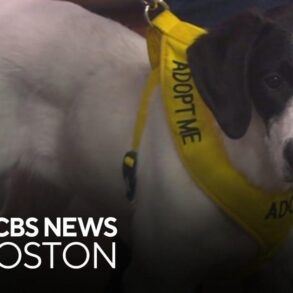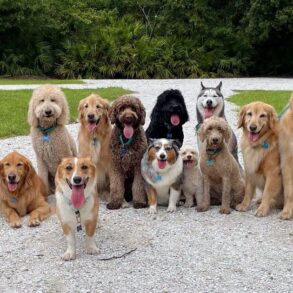Do dogs know it’s Christmas time at all? Of course they don’t, but that doesn’t stop a quarter of Britons now spending as much or more on their pets than their children. We are, we’re told, a nation of animal lovers. In the pandemic, millions of us turned to pets for solace and/or exercise.
But a few years and a cost of living crisis later, many pandemic puppies appear to have outgrown their usefulness; 2023 was a record year for pet abandonments. This year, according to the RSPCA, will prove to have been worse. Every hour on average throughout 2024, two animals have been abandoned by their owners.
At Battersea Dogs and Cats Home, the staff and volunteers try to make a festive fuss on Christmas Day. As well as some gift-wrapped tennis balls and tasty stocking fillers, the inmates are allowed to hear some tunes. On the canine wing, which is full, it’s Wham! and Mariah Carey. Have they not suffered enough? In the cattery, which is also full, they wisely stick to the calmer classics.

SUNDAY TIMES PHOTOGRAPHER JACK HILL
You’d have to have a heart of stone to walk through the kennels and not feel a pang of sorrow for their bemused occupants. The dogs are, of course, well looked after and exercised but they still spend a lot of time in solitary confinement.
Visitors are an excitement. You are welcomed with wagging tails, wide eyes and, unless I’m reading too much into this, anticipation — will this man be getting me out of here?
Advertisement
Nalia, a three-year-old golden retriever, works hard on her appeal: she grabs her chew toy and offers it to me.

Matt Rudd meets Nalia
SUNDAY TIMES PHOTOGRAPHER JACK HILL
Mark, a five-year-old greyhound, opts for a mournful expression. He was, presumably, pampered until he stopped winning races and now he’s here. Mark, I suggest, is a terrible name for a greyhound. Why not Bullet or Usain? My guide’s answer is simple: people already assume, wrongly, that racing dogs need a lot of exercise rather than the odd sprint and then a long lie down. Any name which reinforces that prejudice is a bad idea, so Mark the greyhound it is.

Rebecca Verne, Battersea’s London centre manager, with Mark
SUNDAY TIMES PHOTOGRAPHER JACK HILL
Joy is just ten weeks old and impossibly bug-eyed and small in her cell bed. She shivers with excitement when we say hello. As I start thinking about how, with the right kind of distraction, I could smuggle her out in my coat pocket, the guide reminds me that Joy is a cane corso. In a few months time she’ll weigh 40 kilos. It’s a shame whoever gave her up hadn’t considered this much earlier.

Joy
SUNDAY TIMES PHOTOGRAPHER JACK HILL
The last time I visited Battersea, it was wall-to-wall Staffordshire bull terriers. It was 2013 and the staffy had become the gangland dog of choice and therefore the dog most likely to end up here. Its fearsome reputation made it difficult to rehome even though, they assured me at the time, a staffy really could make the perfect family pet. To prove it, they arranged for Dixie, a young and peaceable terrier, to stay with me and my young children. In the end, I’m ashamed to admit, we rescued a border collie instead, but Dixie was adopted by a Sunday Times reader and they all, last I heard, lived happily ever after.
Today, as always, the inmates of Battersea are a microcosm of wider pet society, but wider society has changed dramatically in the last decade. TikTok wasn’t a thing back then, but today you can tell which breeds have been trending because they’ll start arriving at Battersea a few months later. It’s been a while since any staffies went viral — the gangsters moved on to XL bullies, which culminated in their ban 12 months ago. The staffies are still here but in much smaller numbers. There are new and trendier gangs now – the dalmatians, the lurchers, the English bulldogs, labradors and shih tzus, as well as the lockdown favourites, the cockapoos.
Advertisement
Thanks to Richard Gere, there are also akitas. Hachi: A Dog’s Tale, in which Gere’s character dies at work and his loyal akita spends the next decade waiting at the station for him to come home, went straight to DVD and deservedly so in 2009. It was a real schmaltz-fest. In 2022, it got a second life and a more dog-obsessed audience on Netflix. A few months later, predictably, there was an akita contingent at Battersea.
It was the same with huskies and other wolf crosses after Game of Thrones — people watched Jon Snow cuddle his direwolf and decided they should get one for themselves.
“When you see dogs on television or celebrities get them, they become popular and then we start to see them here,” says Rebecca Verne, Battersea’s London centre manager.
Breeders have become adept at supplying fickle demands. When they noticed, for example, that people liked a bluey black-and-white livery found in very few male border collies, they crossbred that colour pattern into all manner of spaniels and poodles. And when TikTok decided dogs with squashed faces looked cute, well …
Bruce is the first dog I make eye contact with. He’s a three-year-old French bulldog, so the hangdog expression is involuntary. So is his rasping breath — every intake feels like it could be his last. Bruce is the victim of the chronic inbreeding it takes to produce a brachycephalic (short-headed) dog — he is awaiting surgery to widen his airways. That surgery, which would have cost his owner thousands, is scheduled to take place on site early in the new year.
Advertisement

SUNDAY TIMES PHOTOGRAPHER JACK HILL
I ask why Bruce was given up and Verne, keen not to vilify those who choose to give their pets to Battersea rather than just abandon them, tells me it was because of “a change in his owner’s circumstances”. The problem facing Battersea and many other rescue shelters is that circumstances have been changing perpetually since 2020.
In the first year of the pandemic, 3.2 million households responded to our new and unpredictable reality by acquiring a pet. For once, demand outstripped supply; the cost of puppies soared, but so too did inquiries at rescue centres. At one point, Battersea had only 12 dogs left to rehome. Now it’s packed to the rafters again, with 100 in London and another 100 across two more centres, with a waiting list for more animals in need of care.
The cost of living crisis has accelerated the problem. Despite a huge rise in pet food banks and charities offering to help with vet bills, last year’s record number of pet abandonments will be broken again this year. The RSPCA estimates that there will have been almost 23,000 reports of abandonment by the end of 2024, a 30 per cent increase from the 16,118 in 2020.
• Christmas puppy warning over links to criminal gangs
Describing these numbers as “shocking”, the RSPCA is renewing its call for potential pet owners to think carefully before making any commitment. “As a nation of animal lovers, we want to see all animals treated with kindness and respect,” a spokesman said. “Anyone considering a pet should do their research thoroughly to make sure they have the time, resources and money to care for that animal for the rest of their lives.”
Advertisement
Battersea’s three centres here in southwest London, Windsor and Brands Hatch, Kent, are all full this Christmas and the time it takes to rehome abandoned animals is increasing. In 2019, the average stay was 27 days. This year, Bruce and his wrongly imprisoned co-lags will be detained for an average of 36 days.

Matt Rudd with Mark the greyhound
SUNDAY TIMES PHOTOGRAPHER JACK HILL
“Immediately after the pandemic, we were seeing a lot of adolescent dogs that didn’t get the right socialisation,” says Verne. “They weren’t really going out and meeting people, meeting other dogs. There was such an influx of people getting animals, perhaps without the right education about responsible ownership and what that entails. So now we’re seeing older animals with more complex behavioural issues and more complex medical conditions.”
In the difficult days of lockdown, puppy classes were online and vets were hard to see. Vaccinations and check-ups were missed. Small problems such as ear or tooth infections were ignored, only to become bigger and more expensive problems further down the line. “The fallout from that is what we’re seeing now,” says Verne.
There also used to be a kitten season — when cats enjoyed some free love in the springtime. Now, because so many cats weren’t spayed or neutered during the pandemic, kitten season is an all-year problem, as demonstrated by the mewling and meowing up and down the three-storey cattery.
It’s a similar story at Woodgreen Pets Charity, which features in Channel 4’s The Dog House. In the past year, the centre has recorded a 45 per cent rise in strays. “So far in 2024, we’ve taken in 357 stray dogs and only 27 per cent were reclaimed by their owners,” says Helen Stapleton, head of rehoming at the charity. “It’s highly likely the remaining 73 per cent were abandoned.
Advertisement
“During the pandemic, the demand for puppies drove up irresponsible breeding from less reputable sources and we saw an increase in puppies who had been poorly bred, or not well socialised in their early weeks. Sadly, the impact of the pandemic is still evident now. Many dogs come to us because they’ve been left home alone … When people are out of the house for longer, the dog’s behaviour becomes unmanageable.”
There is some good news. Woodgreen, like Battersea, has redoubled its efforts to help owners keep their pets. With education, training and advice about affordable veterinary care and pet food, they’ve seen a recent drop in abandonments. Battersea is also campaigning to convince more landlords to allow pets in rented accommodation; in the housing crisis, many landlords in a renter’s market tightened rules on animals. Many pets are abandoned because a tenant can’t find a cat or dog-friendly property. “People do love their pets,” says Verne. “Giving them up is a last resort. We do everything we can to help them keep them.”
The only dog who doesn’t look up when I visit is Barbra, a one-year-old chocolate mongrel.
“She’s finding it quite hard,” says Verne. “When she’s at home with one of our fosterers, she’s such a happy-go-lucky dog, but look how sad she is in there.” This is one of the many reasons Battersea matches dogs with potential adopters rather than allowing the adopters to pick. Barbra might not be good at selling herself but, Verne assures me, they’ll find her a good home.
On which note, Barbra finally looks up, stretches and walks over to the window to shoot the breeze.
Because, of course, she understands everything we’ve been talking about and is just as disappointed with human behaviour as I am.

SUNDAY TIMES PHOTOGRAPHER JACK HILL

SUNDAY TIMES PHOTOGRAPHER JACK HILL
You can donate to Battersea Dogs and Cats Home here
This post was originally published on this site be sure to check out more of their content.
















































